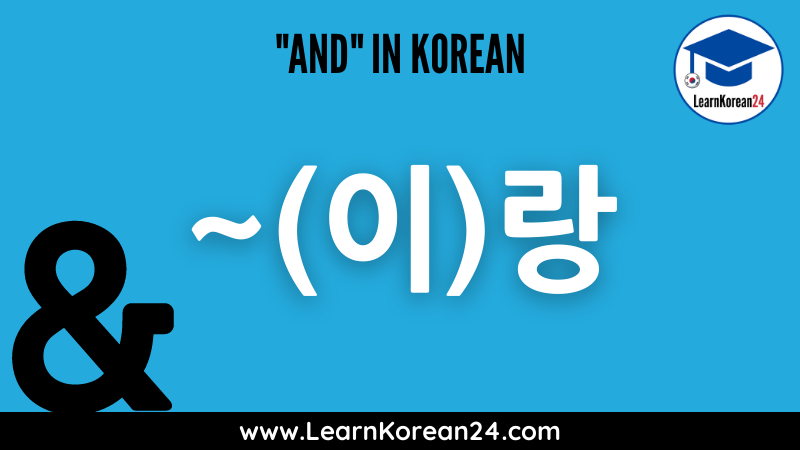And In Korean | ~하고 / ~(이)랑 / ~와/과
In this lesson, you will learn how to say and in Korean. Once you learn how to say ‘and’ in Korean, you will be able to join two clauses together to make longer sentences. There are a few different ways to say ‘and’ in Korean. The ones you will learn today are ~하고 [ha-go], ~(이)랑 [(i)-rang], and ~와/과 [wa/gwa]. As well as meaning ‘and’, these words can also mean ‘with’ in certain situations. Let’s look at each of these words for ‘and’ in more detail.
And In Korean
~하고

The first way to say ‘and’ in Korean we will look at is ~하고. ~하고 can be used with nouns only. To use ~하고 in a sentence, simply attach it to a noun without any space. For example:
사과 = apple
사과하고 바나나 = apple and banana
저는 사과하고 바나나를 샀어요. = I bought an apple and a banana.
This way of saying ‘and’ in Korean is the normal way and the easiest as there are no special conjugation rules. Simply add ~하고 to the noun.
~(이)랑

This next way to say ‘and’ in Korean is the casual way. It is often used in spoken language in casual situations. Just like ~하고, ~(이)랑 can also only be used with nouns. The way to attach ~(이)랑 to a noun depends on the word that comes before it.
If the preceding word ends in a consonant, ~이랑 is attached. For example:
밥 = rice
밥이랑 김치 = rice and kimchi
밥이랑 김치 주세요. = Please give me rice and kimchi.
If the preceding word ends in a vowel, 랑 is attached. For example:
김치 = kimchi
김치랑 밥 = kimchi and rice
김치랑 밥 주세요. = Please give me kimchi and rice.
~와 / 과

Compared with ~하고 and ~(이)랑, ~와/과 is a more polite way to say ‘and’ in Korean and it is often used in written language. Again, the way to attach ~와/과 to a noun depends on the word that comes before it.
If the preceding word ends in a consonant, 과 is attached. For example:
빵 = bread
빵과 우유 = bread and milk
저는 빵과 우유를 샀어요. = I bought bread and milk.
If the preceding word ends in a vowel, 와 is attached. For example:
우유 = milk
우유와 빵 = milk and bread
저는 우유와 빵을 샀어요. = I bought milk and bread.
Other Meanings
~하고, ~(이)랑, and ~와/과 all mean ‘and’ in Korean, but they can also take on the meaning of ‘with’ in some contexts. Here are some examples:
친구하고 부산에 갔어요. = I went to Busan with my friend.
친구랑 부산에 갔어요. = I went to Busan with my friend.
친구와 부산에 갔어요. = I went to Busan with my friend.
Difference Between ~하고 , ~(이)랑, and ~와/과
~하고 , ~(이)랑, and ~와/과 all mean ‘and’ or ‘with’ in Korean, so you are probably wondering what is the different between ~하고 , ~(이)랑, and ~와/과. The main differences are as follows:
- ~(이)랑 is the most casual way to say ‘and’ in Korean and is often used in spoken language in casual situations.
- ~하고 is the normal way to say ‘and’ in Korean. It is also usually used in spoken language. Compared to ~(이)랑, ~하고 is a little more polite because ~(이)랑 is usually used in casual situations.
- ~와/과 is the formal way to say ‘and’ in Korean, and so it is often used in written language. ~와/과 can also be used in spoken language in formal situations. Formal situations are things like news reports, official communications, addressing large groups of people, etc. In these situations, it is much more common to use the formal way to say and in Korean.
Are you ready to get serious about learning Korean? Start our 100% FREE online Korean language course today!

